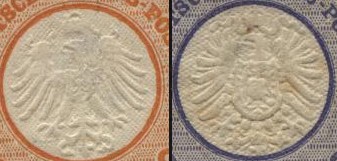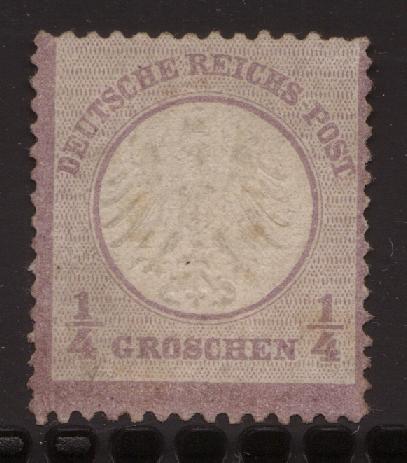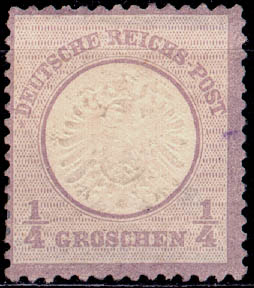 |
|||||
|
|||||
| Preview of Stamps Catalogue: VOLUME 1 |
 |
|||||
|
|||||
| Preview of Stamps Catalogue: VOLUME 1 |
Return To Catalogue - Germany overview
Note: on my website many of the
pictures can not be seen! They are of course present in the catalogue;
contact me if you want to purchase it.
Value in 'groschen'
1/4 g lilac 1/3 g green 1/2 g red 1/2 g orange 1 g red 2 g blue 2 1/2 g brown 5 g brown Value in 'Kreuzer'
1 k green 2 k red 2 k orange 3 k red 7 k blue 9 k brown 18 k brown Surcharged
'2 1/2' on 2 1/2 g brown '9' on 9 k brown
The 'groschen' values were used in Northern Germany, the 'Kreuzer' values in Southern Germany due to the different currencies used there. It was only in 1875 that a single currency, the Mark, was issued in the whole of Germany.

(Left: zoom-in of the small shield; right: zoom-in of the large
shield)
The stamps first appeared with a small shield, but was deemed an inappropriate representation of the German eagle and was thus replaced with the large shield. These stamps first appeared on 1 January 1872.
Value of the stamps |
|||
vc = very common c = common * = not so common ** = uncommon |
*** = very uncommon R = rare RR = very rare RRR = extremely rare |
||
| Value | Unused | Used | Remarks |
'Groschen' values |
|||
| 1/4 g | R | *** | small shield |
| 1/4 g | *** | *** | large shield |
| 1/3 g | RR | *** | small shield |
| 1/3 g | ** | * | large shield |
| 1/2 g | RR | *** | small shield, shades exist |
| 1/2 g | *** | ** | large shield |
| 1 g | RR | c | small shield |
| 1 g | * | c | large shield |
| 2 g | RR | * | small shield |
| 2 g | * | c | large shield |
| 2 1/2 g | RRR | *** | large shield |
| 5 g | RR | *** | small shield |
| 5 g | *** | ** | large shield |
'Kreuzer' values |
|||
| 1 k | RR | *** | small shield |
| 1 k | *** | ** | large shield |
| 2 k | *** | R | small shield, shades exist |
| 2 k | RR | RR | large shield |
| 3 k | RR | * | small shield |
| 3 k | ** | * | large shield |
| 7 k | RRR | *** | small shield |
| 7 k | *** | *** | large shield |
| 9 k | RR | RR | large shield |
| 18 k | RR | RR | small shield |
| 18 k | *** | RR | large shield |
| Overprinted | |||
| '2 1/2' on 2 1/2 | *** | *** | large shield; introduced to avoid confusion with the 5 g stamp. |
| '9' on 9 | *** | R | large shield; introduced to avoid confusion with the 18 k stamp. |
'Imperforated stamps" with no coloured border are cuts from envelopes, examples:

(Reduced size)
Postal stationery exist of the 1/2 g red, 1/2 g
brown, 1/3 g green, 1 g red, 1 k green, 2 k orange, 3 k red, 7 k
blue, 9 k brown and 18 k brown values.
Genuine imperforate stamps of the 5 g large shield were used in
Stettin, where a few sheets were given to the public. Other
imperforate stamps exist of the values 1/2 g and 1 g.
A postal forgery of the 5 g was made in Elbing, the so-called Elbinger Postfälschung. This forgery was made by a postal worker of this town and is rather deceptive. The forger made both forgeries of the small and large embossed eagle. In my opinion, the 'C' of 'REICHS' is too open.
Typical cancel, horseshoe cancel ('Hufeisenstempel'):



(Horseshoe cancel on a postal stationery, reduced size)
Notes on the embossing:


(Left small eagle, right large eagle, I presume both genuine)
Forged embossed eagles exist. Some small embossed
eagle stamps have higher value than the large embossed eagle. The
embossing is first ironed out and then a new embossing is printed
in making the stamp more valuable. The inverse is true for the 2
Kr stamp, this stamp is more valuable with the large embossing
than with the small embossed eagle, consequently forgeries exist
with the small eagle replaced by a large one. It seems that all
inverted embossings are forgeries. (Source 'Fakes & Forgeries
of Germany & Colonies' by The German Philatelic Society Inc.
Stamps with inverted embossing are always forgeries! The forger Georges Fouré is known to have made
forgeries of the 7 k with wrong embossing. I have no further
information.

Stamp with forged embossed center, 18 k large shield

Zoom-in of forged embossed center

A 2 k stamp with forged embossing
A forged cancel on a 18 kr stamp with large embossed eagle:

A reprint made for the 'Salon der Philatelie zum XIX.
Weltpostkongress Hamburg 1984', probably printed by Gehringer
Another 'reprint' exists for the 'Ausstellung <Philatelie in der DDR> auf der Philatelia Koln 89', it has this text in a minisheet together with a reprint of the 1/2 g orange stamp with additional text 'Freimarken- Ausgabe Juni/November 1872 Ministerium fur Post- und Fernmeldewesen der DDR'.
2 M red (1875) 10 g grey 30 g blue
These stamps are generally cancelled with the signature of the postmaster (by order of the postal authorities). Stamps with other postmarks are erroneously applied (much more valuable, however forged cancels are quite common).
Value of the stamps |
|||
vc = very common c = common * = not so common ** = uncommon |
*** = very uncommon R = rare RR = very rare RRR = extremely rare |
||
| Value | Unused | Used | Remarks |
| 10 g | *** | *** | |
| 30 g | R | R | |
| 2 M | *** | * | many colour shades exist |
The unused remainders of the 10 g and 30 g stamps were sold to stamp dealers.
Postal stationnary of the same period (issued 1873), eagle, inscription 'DEUTSCHE REICHS-POST EIN HALBER GROSCHEN', brown:

(Reduced size)
A similar design exists for the southern territories, but then with the value in 'KREUZER': 2 k brown:
